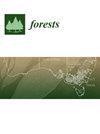构建中国北京两种主要树种幼树的加性异速生物量模型
IF 2.4
2区 农林科学
Q1 FORESTRY
引用次数: 0
摘要
传统的体积生物量法由于没有充分考虑幼树的碳汇,导致低估了森林生态系统的碳汇能力,因而具有局限性。因此,迫切需要建立幼树异速生物量模型,为准确估算幼树的碳储量和碳汇提供定量依据。本研究采用的破坏性数据包括中国两种优势树种(Betula pendula subsp. mandshurica (Regel) Ashburner & McAll 和 Populus × tomentosa Carrière)的幼树生物量,由地上生物量(Ba)、地下生物量(Bb)和总生物量(Bt)组成。选择了单变量和双变量维度,并对五个候选生物量模型进行了独立测试。分别采用比例函数控制法和代数和控制法建立了两个幼树加性异速生物量模型系统。我们发现,Logistic函数最适合解释幼树Ba、Bt和胸径(D)之间的异速增长关系;幂函数最适合解释幼树Bb和D之间的异速增长关系。与独立拟合模型相比,两个加性异速生物量模型系统提供的加性生物量预测反映了实际情况。Bt 模型和 Ba 模型的准确度较高,而 Bb 模型的准确度较低。在单变量和双变量两个维度上,我们发现双变量加性异速生物量模型系统的准确性更高。在单变量维度上,比例函数控制法优于代数和控制法。在双变量维度上,代数和控制法优于比例函数控制法。加性异速生物量模型为估算幼树生物量和实现生物量组分的加性提供了可靠的依据,在碳储量监测和碳汇评价等方面具有广阔的应用前景。本文章由计算机程序翻译,如有差异,请以英文原文为准。
Construction of Additive Allometric Biomass Models for Young Trees of Two Dominate Species in Beijing, China
The traditional volume-derived biomass method is limited because it does not fully consider the carbon sink of young trees, which leads to the underestimation of the carbon sink capacity of a forest ecosystem. Therefore, there is an urgent need to establish an allometric biomass model of young trees to provide a quantitative basis for accurately estimating the carbon storage and carbon sink of young trees. The destructive data that were used in this study included the biomass of the young trees of the two dominant species (Betula pendula subsp. mandshurica (Regel) Ashburner & McAll and Populus × tomentosa Carrière) in China, which was composed of the aboveground biomass (Ba), belowground biomass (Bb), and total biomass (Bt). Univariate and bivariate dimensions were selected and five candidate biomass models were independently tested. Two additive allometric biomass model systems of young trees were established using the proportional function control method and algebraic sum control method, respectively. We found that the logistic function was the most suitable for explaining the allometric growth relationship between the Ba, Bt, and diameter at breast height (D) of young trees; the power function was the most suitable for explaining the allometric growth relationship between the Bb and D of young trees. When compared with the independent fitting model, the two additive allometric biomass model systems provide additive biomass prediction which reflects the conditions in reality. The accuracy of the Bt models and Ba models was higher, while the accuracy of the Bb models was lower. In terms of the two dimensions—univariate and bivariate, we found that the bivariate additive allometric biomass model system was more accurate. In the univariate dimension, the proportional function control method was superior to the algebraic sum control method. In the bivariate dimension, the algebraic sum control method was superior to the proportional function control method. The additive allometric biomass models provide a reliable basis for estimating the biomass of young trees and realizing the additivity of the biomass components, which has broad application prospects, such as the monitoring of carbon stocks and carbon sink evaluation.
求助全文
通过发布文献求助,成功后即可免费获取论文全文。
去求助
来源期刊

Forests
FORESTRY-
CiteScore
4.40
自引率
17.20%
发文量
1823
审稿时长
19.02 days
期刊介绍:
Forests (ISSN 1999-4907) is an international and cross-disciplinary scholarly journal of forestry and forest ecology. It publishes research papers, short communications and review papers. There is no restriction on the length of the papers. Our aim is to encourage scientists to publish their experimental and theoretical research in as much detail as possible. Full experimental and/or methodical details must be provided for research articles.
 求助内容:
求助内容: 应助结果提醒方式:
应助结果提醒方式:


